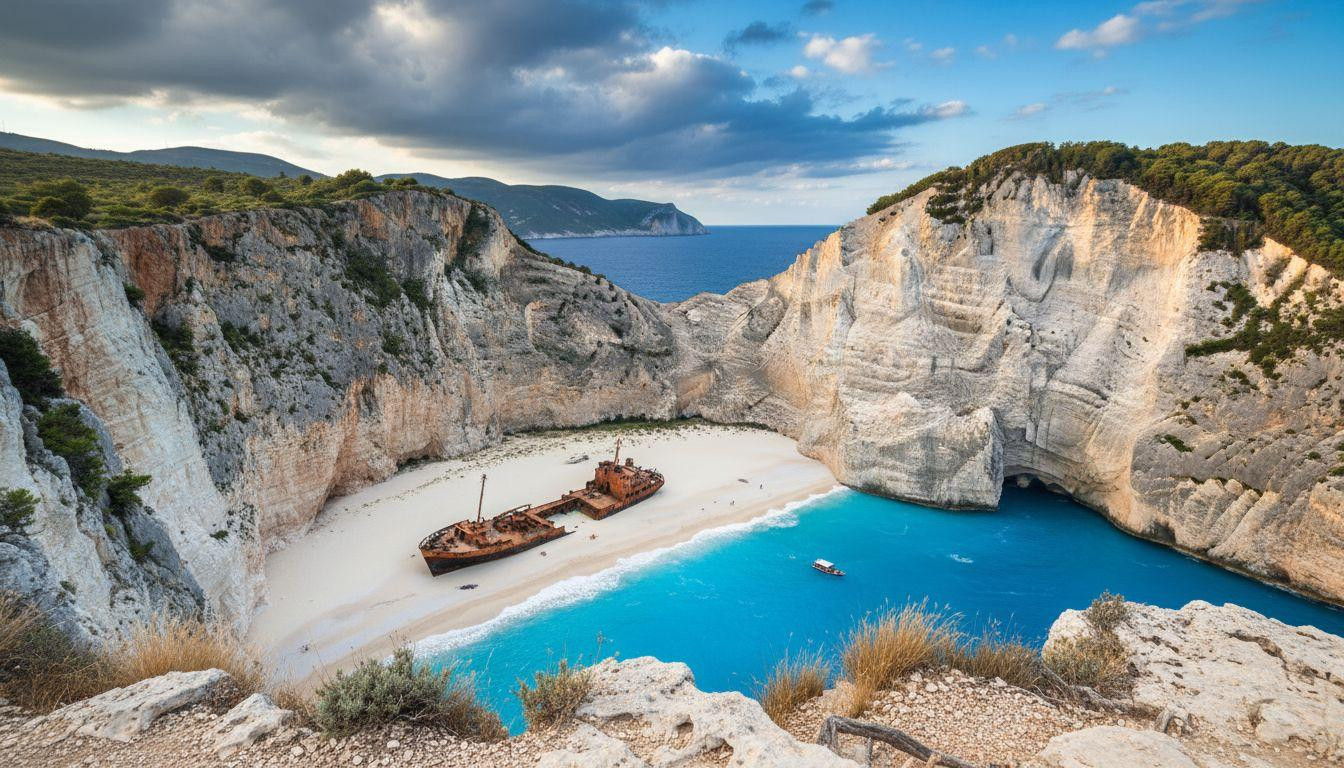The boat cuts through turquoise Ionian water at 10:47 AM on November 13, 2025, approaching a cove that shouldn’t exist. Between 650-foot limestone cliffs, a rusting freight ship rests on white sand like a sculptural relic. This is Navagio Beach, where a 1980 mafia smuggling incident created Greece’s most photographed coastline.
Accessible only by sea, the beach receives fewer visitors in November’s 66°F temperatures. Yet this offers what summer’s crowds obscure: the unhurried encounter between geological deep time, recent maritime drama, and Mediterranean color that photographs can’t quite capture.
The beach that became famous by accident
Navagio Beach occupied the northwestern coast of Zakynthos for millions of years under the name Agios Georgios (Saint George). It remained unremarkable among hundreds of Ionian coves until October 2, 1980, when the MV Panagiotis changed everything.
The freight vessel, allegedly contracted by the Camorra to transport 2,000 boxes of contraband cigarettes worth $750,000, encountered engine failure during storms. An SOS went unanswered. Winds drove the ship toward the rocky cove, where it ran aground between limestone cliffs 650 feet high.
The nine crew members (seven Greeks, two Italians) escaped unharmed. The ship remained. Over 45 years, rust transformed steel into sculpture, contraband mythology into tourist magnetism. This remote island paradise now ranks as Greece’s second-most-photographed site after the Acropolis.
Where turquoise water meets limestone time
The impossible color palette
The beach presents colors that challenge photographic credibility. Brilliant turquoise water saturated to near-Caribbean intensity contrasts with fine white sand and weathered rust-orange ship hull. Pale limestone cliffs stratified across geological epochs complete the scene.
Midday light bleaches everything to maximum intensity, creating impossibly blue water. November’s lower sun angle extends golden hours: dawn arrives horizontally at 7:12 AM, illuminating cliff faces with amber tones. The water deepens to sapphire as afternoon light approaches 5:03 PM sunset.
The natural amphitheater
The 650-foot cliffs create acoustic and visual containment. Waves lapping sand echo subtly off vertical faces. Human voices carry strangely amplified across the 280-foot-wide cove.
November reduces crowds substantially with only 4-5 hours daily sunshine and 54-61°F evenings. This discourages casual visitors, leaving the beach to those comfortable with weather uncertainty and earned isolation. Similar dramatic coastal geography exists throughout the eastern Mediterranean.
The wreck that tells two stories
What history documents
Official records establish key facts. The MV Panagiotis departed Kefalonia on September 13, 1980, carrying approximately 2,000 boxes of cigarettes valued at 30 million drachmas. The cargo was allegedly contracted by Camorra intermediaries for Italian delivery.
A payment dispute led to Italian hostages aboard the vessel. The captain redirected course toward Greek waters when mechanical failure struck during October 1 storms. Engine unreliability, failed SOS, and naval flare preceded the forced grounding in the cove.
The crew was rescued. The ship was abandoned and gradually settled into sand where it rests today, increasingly integrated into the beach landscape as rust oxidizes steel and salt corrodes surfaces.
What mythology adds
Local narratives embellish documented events with hidden treasure claims and ghost sailor sightings. Residents allegedly looted cigarettes before authorities arrived, hiding contraband across the island and slowly selling inventory. This earned the informal designation “Smugglers Beach.”
According to regional tourism boards, 29 Zakynthos residents were charged with theft. Local folklore claims no cigarette packs were sold on the island for years afterward. These layers enhance the beach’s mystique for visitors seeking authenticity beyond conventional tourism photography.
November’s contemplative advantage
November transforms Navagio Beach’s character fundamentally. Summer’s 82-88°F heat and 10-11 hours daily sunshine draw peak crowds creating photographic competition. November’s 66-68°F days, 4-5 hours sunshine, and occasional storms discourage casual visitors.
Boat access depends on sea conditions. November’s increased rainfall and rougher waters occasionally prevent departures, adding genuine unpredictability. Fewer tourists create psychological space where the beach feels more like earned discovery than packaged tourism.
November’s light (golden, lower-angled, occasionally cloud-diffused) creates photographic opportunities impossible in summer’s brilliant clarity. Similar atmospheric timing rewards contemplative visitors across coastal destinations.
Your questions about Navagio Beach answered
How do you actually reach the beach?
Boat-only access operates from Porto Vromi and Laganas Bay with journey times 15-45 minutes depending on departure location. Standard group tours cost $30-45 per person. Private water taxis offer flexibility at $200+ per trip.
No road access exists. The beach’s isolation results from deliberate geographic protection. November’s weather affects departure frequency as rougher seas occasionally cancel trips, adding genuine unpredictability versus summer’s reliable daily service.
What does November weather actually feel like?
Expect 66-68°F daytime temperatures, 54-61°F evenings, and 68-70°F sea temperature (cool but swimmable for cold-tolerant visitors). Sunshine averages 4-5 hours daily representing 52% of daylight availability.
Pack layers, waterproof jacket, and sun protection for intermittent clear periods. Rainfall totals 6-7 inches monthly across 12 rainy days, but showers are often brief and followed by dramatic light conditions.
How does this compare to other Greek beaches?
Navagio Beach’s combination (dramatic cliffs plus historic wreck plus boat-only access) distinguishes it from alternatives. Myrtos Beach on Kefalonia offers similar white-sand limestone-cliff aesthetic without the shipwreck element and with road access.
Most Greek beaches prioritize either natural beauty or historical interest. Navagio delivers both accidentally. Limestone architecture elsewhere provides cultural depth to balance coastal natural drama.
The boat returns at 3:47 PM as November light turns amber across limestone cliffs. The MV Panagiotis catches final sun, rust glowing copper against deepening indigo water. This beach exists because a ship failed during a storm 45 years ago. Some destinations are designed. Some just happen.
